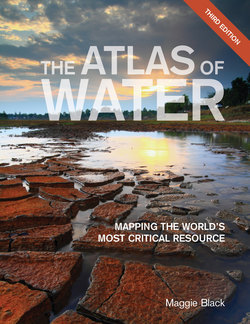Читать книгу The Atlas of Water - Maggie Black - Страница 17
На сайте Литреса книга снята с продажи.
ОглавлениеThe volume of water in the world never changes, but only 2.5 per cent is fresh. More than two-thirds of fresh water is locked up in polar ice-caps and permanent snow cover. Of the rest, a small proportion is in lakes and streams, and the rest in underground aquifers. Working in tandem, salt and fresh waters power life on Earth by a dynamic and constantly regenerative process. The sun’s heat evaporates water from seas and lakes, and moisture in vegetation is absorbed into the air through evapotranspiration. Once in the atmosphere, water vapour condenses into droplets. Clouds form from which
rain and snow are released. This replenishes rivers and aquifers, enabling them to nourish soil fertility and promote plant growth. The “hydrological cycle” depicts the forces energizing and controlling the movement of water from land, to sea, sky, and back to land. This 20th-century gem of hydrological analysis has had an important influence on ideas of a “global water supply” to be shared among humankind, and the pressures on that supply that today constitute a “global water crisis”. However, it is at the local level – arid, temperate, tropical, mountainous, riverine – that humanity interacts with water, storing, conserving, managing and distributing it. This is also where the impacts of climate change – rising sea levels, changed rainfall patterns – are felt. “Global water”, for all practical purposes, is simply a useful construct.
Global Water
20
